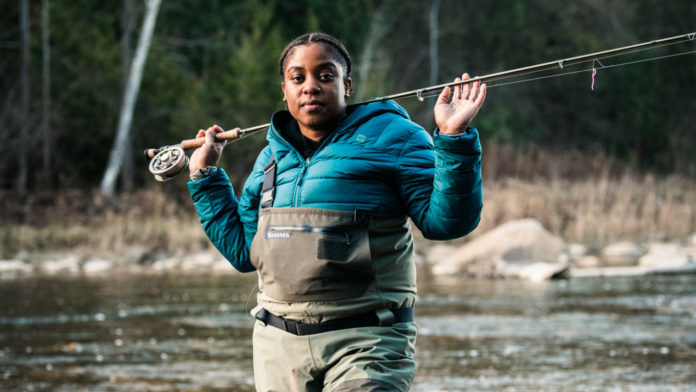Now that school is officially out and summer has set it, it’s time to start looking for activities that are fun for the whole family. Fortunately, Family Fishing Week in Ontario is coming up! From July 3 to July 11, Canadian residents can fish in Ontario without the otherwise mandatory fishing and outdoor licenses. While usually these are issued to prevent over-fishing and can cost up to $26 for a year of fishing, this week gives residents a chance to get the whole family out to try the activity free of charge.
We’ve enlisted the help of Demiesha Dennis, founder and CEO of Brown Girl Outdoor World, for some expert advice on how to start fishing in Toronto.
Preparations and equipment
Before you can plan your day, it’s essential to check the regulations for the area where you plan to fish. Different areas have different restrictions on how much and when you can fish, as well as the type of bait and hooks you can use. You can check these regulations with the Ministry of Natural Resources and Forestry.
Once you’ve checked the regulations, you’re ready to head out and purchase your equipment. When shopping for a rod, Dennis suggests the best one is the one that’s most comfortable for you and in your price range. When she first came to Canada, Dennis started fishing with a stick, a piece of crochet thread and a safety pin. “But,” she says, “I wouldn’t advise going that route.”
Most people begin with a combination rod. These already have the rod, reel and fishing line assembled. As a beginner, another helpful piece of equipment is the red and white bobber. It will float on the water and act as a visual cue when you’ve hooked something or when something is nibbling at your line.
The type of bait you use will depend on the regulations of where you plan to fish. “The easiest thing to use is probably the live worm,” says Dennis. After all, is there really a better way to enjoy the outdoors than to roll up your sleeves and get down and dirty digging for worms?
As for what to wear, waders may not be the most fashionable thing, but if you plan on trudging through the water all afternoon, they’re your best bet for staying dry and warm. Dennis also recommends wearing a hat, to not only protect yourself from the sun, but to protect yourself from getting hooked on a bad cast!
Casting, Hooking and Reeling
A good cast depends largely on where you’re fishing and the rod you’re using. On a combination rod, you’ll want to put your hand around the base of the reel, with your index finger on top. Grab your line, keeping it taut, and open the reel. Then, make sure you have plenty of space behind you, swing your rod straight back and bring it forward in one motion as you release your index finger off the line. The amount of power to put into your cast is something that comes with practice, so don’t be discouraged if you don’t master it off the start.
If you’re unsure of when to start reeling, Dennis’ tip is when in doubt, just reel it out. “If you think you’ve hit a rock or feel tension on your line, you hook that because the moment you think it’s not a fish, it’s actually a fish nibbling.”
Depending on the type of fish, you’ll usually want to reel it in quickly, because you don’t want to cause unnecessary stress if you’ll be releasing the fish again.

Best fishing spots in Toronto
One of Dennis’ favourite places to fish in the city is along the Humber River. The range of parks and bay areas are perfect for catching pike, bass and trout. Carp fishing is very popular in the marshes, and you’ll also get lucky with pike since they like the shallow, weedy areas. Sunfish, which are also common at the marshes, are great for beginners as they can be caught any time of day and are normally found in large packs. They can be found hanging out under the shaded docks of the marina.
Tommy Thompson Park is another perfect fishing location for beginners. With bass season opening at the end of June, this is a good spot to catch largemouth bass near the shallow shoreline, while the bays make a good habitat to find perch. Other species include brown bullhead, northern pike, lake trout and a variety of forage fish. Be aware that no live bait is allowed in the park to limit the risk of introducing invasive species. Only worms and artificial lures are allowed.
Where to buy and rent equipment
Dennis recommends Toronto’s independent fishing and tackle shops as the best places to go for expert advice on suitable gear and for tips on the best fishing locations. All Nation Fishing, located at 1816 Jane Street, has a small shop full of all the equipment you’ll need, including fresh, live bait at an affordable price. While there, you can even purchase a fishing license to continue the fun all summer long.
Al Flaherty’s Outdoor Store has been operating at 2066 Dufferin Street since the late 1940s. Though originally it served as an army shop, Al Flaherty now sells all the outdoor adventure gear needed to kickstart your summer including camping, fishing and hunting equipment. Between rods, reels, lures and tackle boxes, this large outfitting store has everything you’ll need for a day spent by the water.
Once you’re a pro and want to give fly fishing a try, Drift Outfitters and Fly Shop is a one-stop-shop downtown for everything fly fishing. The expert and friendly staff will help with all your questions and concerns, no matter how new you are to the sport. Drift additionally offers useful resources like blog posts and instructional live YouTube videos on fly tying. You can visit them in store at 199 Queen Street East.
Credit: Source link





























